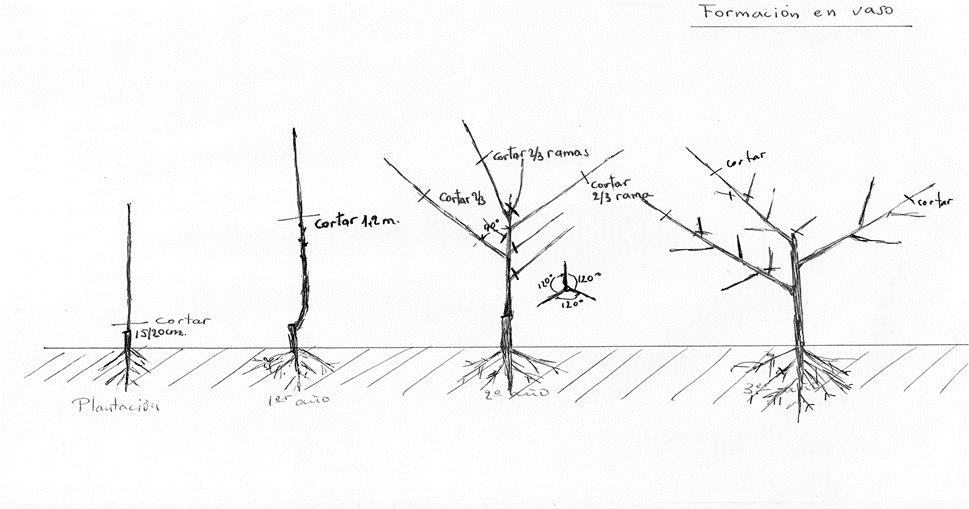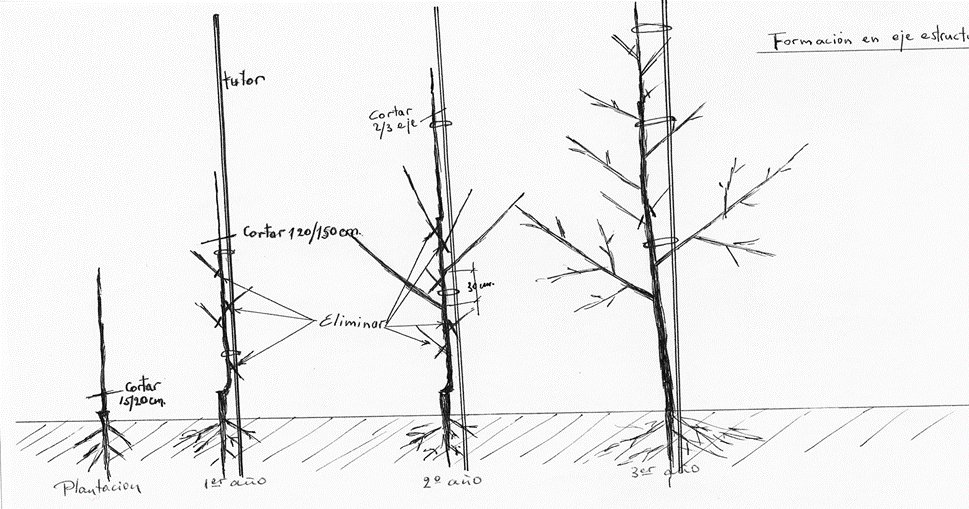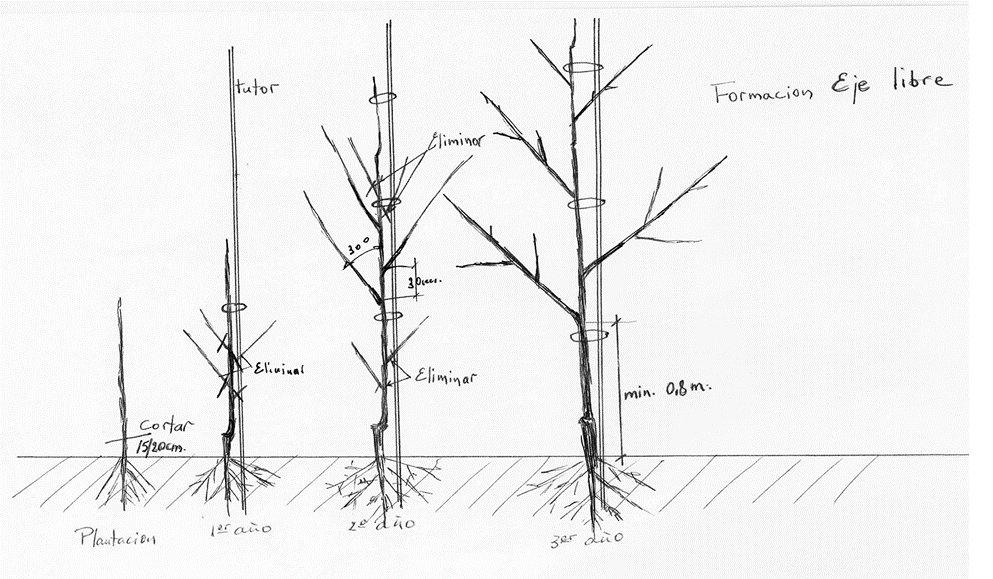WALNUT TREE PRUNING
Pruning is very important in the early years of a walnut grove. It affects the development of the tree in the future, rapid entry into production and the possibility of mechanical pruning of mature trees
There are three walnut formation pruning systems:
- Traditional prunning, open vessel
- Central axis structure
- Free axis structure
The choice of one of three ways, depending on several factors, how important each variety vegetation (like Franquett varieties and other classical French and Serr, adapt better to the glass, while new varieties as Chandler , Howard, Tulare, etc. readily admit formations axis). Another important factor to consider is the knowledge of people pruning should be carried out: sometimes it is easier to adapt the means chosen to practice trimmers to test new systems.
Axis ways, allow a slightly increased number of plants per hectare., Which increased production is accomplished the early years. In adulthood, the output should not vary substantially if the pruning is done correctly.
Also pruning axis mechanical systems can apply pruning mature trees, which is more difficult formations in glass.
Comparing the three systems, we can state:
- Tests performed by IRTA, Tarragona, note that, from age 7, structured production axis, is always higher than the training vessel.
- INRA trials in Bordeux, with the variety Pedro (the more similar their characteristics to new varieties) show increases in production, at age 7, 10% and 46% between structured and free shaft axis, respect to the vessel, while at age 13 the differences are 21% and 9%, respectively.
- Free axis is best suited to production in hedge. Assays Station Creysse show that at 10 years the production is significantly higher than the other systems. Need to know whether you will keep more years, and the quality obtained.
VESSEL
Planting: If we use a tree nursery, bare root, it is advisable to plant in January, February, as the root begins to develop in spring and start sprouting this tree is more vigorous. If we use plants in containers is ideal for planting in August, September, so that the plant rooted in the same year and at the & nbsp; next year is much better development. Likewise, the use of container plants and planting in winter, facilitates the growth of the tree, because we do not cut any roots.
A plantation, in the case of bare root plants and winter plantings container plant, it is essential to lower the seedling 20 cm. On the point of the graft. Walnut is a plant that takes root slowly (usually the rootstock, the plant has 2-3 years) and, instead, flows rapidly in the spring, thus an imbalance between aerial and root part occurs, causing stop growth in summer, making a very vigorous plant, which can bind to lower the ground again, the end of the first winter to have a large seedling vigor, to initiate the formation of the glass. The plant in container plantations, made in summer, can avoid undercutting the plant to 20 cm., If we trees 1.2 to 1.5 meters. In this level is not achieved, it is best to cut them in winter to 20 cm.
It is advisable to place a tutor, who can be a bamboo or iron rod, best covered by a polyethylene tubing used in drip. This tutorial gives us a straight growth, while holding a protector & nbsp; to use herbicides and safeguard the tree of animals.
It is recommend adding a tutor, who can be a bamboo or iron rod, best covered by a polyethylene tubing used in drip. This tutorial gives us a straight growth and at the same time securing a protector to use herbicides and safeguard the tree of animals.
In winter the first year, all side shoots are removed and trimmed the main 1.2 / 1.4 meters, according vigor, considering that the wood should be round and hard. It is better to cut a little lower than doing it on little parched wood, because the side shoots obtained the following spring would be of poor quality. If you can not have this height, cut back to 20 cm., Assured that the next year, a large development will be achieved.
To force out well placed branches to form the cup, is recommended remove the top bud (of the two that used to have) in the chosen points. Thus we achieve a more open and less risk of breakage side branches.
During the summer of the second year, we chose the three branches that form the crown, cutting others 20-30 cm. (will be removed in winter). Preferably, are positioned distributed around the axis, at angles of 120 degrees between them, and an open angle with the axis.
In winter, sprouted buds are removed in summer and the three elected branches are lowered 2/3 to balance the tree.
From this time, the tree must be substantially structured. We merely correct, with summer pruning or winter, the situation of some defect branches, replacing, for example on the other, in case of breakage or closed angle, etc.
In summer, we suppress pacifiers, blunting the main branches which has a much higher than others in the same tree growth, and also branches despuntamos not intended for secondary. In any case tend to have a regular plant development and eliminate those that may represent a competition to the structural ones.

STRUCTURED AXIS
Planting: If we use a tree nursery, bare root, it is advisable to plant in January, February, as the root begins to develop in spring and starting sprout this tree is more vigorous. If we use plants in containers is ideal for planting in August, September, so that the plant rooted in the same year and the next year is much better development. Also the use of container plants and planting in winter, facilitates the growth of the tree, because we do not cut any roots.
To the plantation, in the case of bare root plants and winter plantings container plant, it is essential to lower the seedling 20 cm. On the point of the graft. Walnut is a plant that takes root slowly (usually the rootstock, the plant has 2-3 years) and, instead, flows rapidly in the spring, thus an imbalance between aerial and root part occurs, causing stop growth in summer, making a very vigorous plant, which can bind to lower the ground again, the end of the first winter to have a large seedling vigor, to initiate the formation of the glass. The plant in container plantations, made in summer, can avoid undercutting the plant to 20 cm., If we trees 1.2 to 1.5 meters. If this level is not achieved, it is best to cut them in winter to 20 cm.
It is recommend adding a tutor, who can be a bamboo or iron rod, best covered by a polyethylene tubing used in drip. This tutorial gives us a straight growth, while holding a protector & nbsp; to use herbicides and safeguard the tree of animals. In the case of axis formation, the guardian must be three meters, to keep the straight axle up to this point. A good solution is bamboo stakes, but in this case should be 35-40 mm. diameter or treated pine, which are more expensive.
During the first summer, the most vigorous and best bud set is chosen to continue the shaft and blunts to 20 cm. everyone else (which will be removed in winter). The outbreak chosen to be tying tutor, as it grows. In winter, all the side shoots are removed and cut the main 1.5 meters, approximately. If you miss this point this point is lowered to 30-40 cm. and delays the formation year. If the plant is high enough (more than 1.5 m.) And have blunt, we can remove the top pad of the places where we want to have the main branches, so we force sprouting from the bottom, which will give us angles more open. In any case, the main branches should be initiated at a lower than 1.2 meters high, which oblige us to remove them once the adult tree, and that would hamper the cultivation and harvesting.
In the second summer, we just shoot dawn structural unselected as to slow its growth. The structural despuntaremos slightly, if any has a growth or the other bronzed. At the same time we remove the buds that compete with the axis must always be dominant, and continue attaching the axle to the tutor, to ensure good vertical growth. Here we must note that some varieties are poorly adapted to this formation, by the very tendency to grow long side branches (more than the central axis) and end up being dominant. Serr is the case, and, pretty in Franquette. In these cases it is better, surely, opt for training in glass, on pain of having busy summer training and have no guaranteed success.
In winter, we cut the axis 50/100 cm, depending on their growth, to form new floors, and main branches chosen are cutted about a third. So we get the formation of secondary branches. The shoots that have appeared in unwanted places, are eliminated.
Similarly we proceed in the following years, to form structural floors 5-6, with their side branches, time when the tree growth will greatly reduce or stop because they are already in production.

FREE AXIS
This structure is substantially equal to the structured axis. The main difference is that the acis is not trimmed every year.
No different planting and the need to cut the seedling to 20 cm. If we plant container plants, especially if the planting is in summer need not be blunting the tree as a good balance between the underground and aerial part is achieved.
In the summer of the first year, we simply promote the growth of the axis, eliminating shoots competing with and blunting those that appear less than 1 meter above the ground (to remove in winter).
In winter, do not blunt the axis, but eliminate branches in 50 cm to promote growth the following year. Not touch lateral branches except those that have a very tight angle that will compet with the axis. Also must be removed branches departing from the same point or very close. It can made in the following years with the tree already in production if we observe that, with growth, do not allow adequate lighting and ventilation.
We note that with this training system, we intend to have a tree without structural branches, with very little pruning on the first years, and that all branches productive. Without doubt the reason is to have a more rapid entry into production and reduce the hours of pruning. It should be mentioned that some varieties it fit easily, especially those not very vigorous, have provided very good soil and watering without any problem. For varieties that little branch and branches of great vigor, is difficult to implement and may require even using bonds to force open the angles of the branches, the early years.
If we maintain a good vegetative balance, this system makes it much easier mechanical pruning and productivity .. In the early counterpart is problematic if the plantation stress presents problems for some reason: soil problems, lack of irrigation, etc. Allows more intensive plantations until trees 350 frames per hectare.
